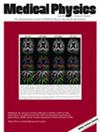Verification of dose and dose rate for quality assurance of spread-out-Bragg-peak proton FLASH radiotherapy using machine log files
Abstract
Background
Ultra-high dose rate radiotherapy elicits a biological effect (FLASH), which has been shown to reduce toxicity while maintaining tumor control in preclinical radiobiology experiments. FLASH depends on the dose rate, with evidence that higher dose rates drive increased normal tissue sparing. The pattern of dose delivery also has significance for conformal proton FLASH delivered via pencil beam scanning (PBS) given its unique spatio-temporal distribution of dose deposition.
Purpose
In PBS, the machine-generated log file contains information on the spatio-temporal pattern of PBS delivery measured by the segmented ionization chambers in the treatment nozzle. The spot position and monitor unit (MU) obtained from log files have previously been used to reconstruct the treatment dose by Monte Carlo (MC) simulations. The incorporation of spot timing allows reconstruction of the 3D temporal dose distribution. The log-based dose and dose rate can have a role in quality assurance (QA) and FLASH treatment verification if the reconstruction can be shown to be accurate in spatial and temporal domains of dose deposition. Thus, the objective of this study is to validate the accuracy of dose rate reconstruction using input data from machine log files of PBS delivery. By analyzing the delivered spot timing, position, and MU extracted from the logs, we aim to evaluate the reliability and precision of the log data for dose and dose rate reconstruction.
Methods
FLASH PBS spread-out Bragg peak (SOBP) treatment fields were delivered using a cyclotron accelerated proton beam. This method involves a patient and field-specific conformal energy modulator (CEM) to achieve a SOBP at the tumor site. Log files record spot positions and the delivered MU with timing information at 250 µs resolution. To validate timing information, a 9.9 mm diameter parallel plate ionization chamber was positioned at various locations within the SOBP. An electrometer sampling at 20 kHz recorded the time-resolved ionization current collected by the ionization chamber. These measurements were used to determine spot dose, dose rate, duration, and transition times. Disparities between the measured and logged spot map MU and timing were determined. Dose average and PBS dose rates were compared between the measurement and log-based MC simulations.
Results
There was a good agreement between the measured dwell time and transition time and the logged information across various detector positions. The median disparities for inter-spot dwell time range from -0.041 to 0.024 ms. Differences between logged and planned spot positions are minimal, measuring less than 1.08 mm in the x direction and 1.15 mm in the y direction, consistent with prior studies and the spatial resolution of the PBS nozzle ionization chamber. Delivered MU were within 1.9% of the planned MU. Measured dose and dose rates are consistent with simulated outcomes derived from MC simulation.
Conclusion
We validated the precision and accuracy of PBS log file data through measurements and MC simulations. These findings support the use of log files in MC calculations as one part of patient-specific quality assurance (PSQA) and dose rate delivery verification for conformal proton FLASH radiotherapy with SOBP.


 求助内容:
求助内容: 应助结果提醒方式:
应助结果提醒方式:


